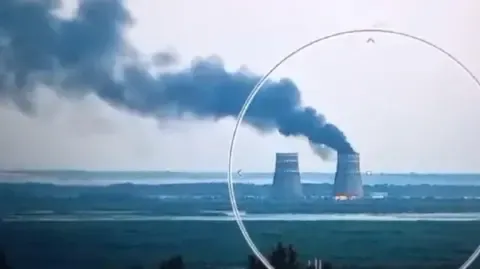Introduction
On a fateful Sunday, the Zaporizhzhia Nuclear Power Plant, Europe’s largest nuclear facility and a symbol of energy prowess, became the epicenter of a dangerous dispute between Ukraine and Russia. As flames and smoke billowed from the plant, accusations flew from both sides, each blaming the other for the fire. This incident, coming amidst a significant escalation in the conflict, underscores the high stakes and deep-seated tensions that define the ongoing war between the two nations.
The Fire at Zaporizhzhia: Initial Reports
The Incident
On Sunday, a fire broke out at the Zaporizhzhia Nuclear Power Plant, located in southeastern Ukraine. This facility has been under Russian control since early 2022, and its strategic importance cannot be overstated. Reports indicated that the fire had affected the cooling towers of the plant, an area critical to maintaining the safety of the facility.
Ukrainian President Volodymyr Zelensky swiftly accused Russian forces of deliberately igniting the blaze. He claimed that this act was part of a broader strategy to exert pressure on Kyiv and create a crisis situation. On the other hand, Yevgeny Balitsky, the Kremlin-installed governor of Zaporizhzhia, attributed the fire to Ukrainian shelling. Balitsky urged for calm, emphasizing that there had been no radiation spike detected around the plant.
The International Response
The International Atomic Energy Agency (IAEA), the UN’s nuclear watchdog, provided a crucial update. Their experts reported seeing “strong dark smoke” emanating from the plant following “multiple explosions.” Despite these alarming observations, the IAEA confirmed that there was no immediate threat to nuclear safety. The agency’s statement highlighted that the plant had previously experienced an “alleged drone attack” on one of its cooling towers, though this did not escalate into a nuclear emergency.
The Zaporizhzhia Plant: Context and Current Status
Historical Background
The Zaporizhzhia Nuclear Power Plant has been a focal point of tension since Russia’s full-scale invasion of Ukraine in February 2022. It has been under Russian military control for over two years. The plant, which has six reactors, had been operational before the invasion but has been in cold shutdown since April 2023. This status means that the reactors are not generating power but still require careful management to ensure safety.
Recent Developments
Prior to the fire, the plant had not produced any electricity for over two years. The cooling towers affected by the recent blaze are crucial for maintaining the safety of the reactors, even when they are not operational. The fire’s impact on these structures could potentially pose risks if not managed properly, although the IAEA’s report reassured that there was no immediate danger of radiation release.
The Broader Conflict: Ukraine’s Cross-Border Offensive
Ukrainian Advances
The fire at Zaporizhzhia coincides with a significant development on the battlefield. Ukrainian troops have launched a major offensive into Russian territory, specifically targeting the Kursk region. This operation represents the deepest Ukrainian incursion into Russia since the beginning of the full-scale invasion. President Zelensky publicly acknowledged this cross-border operation in a recent address, framing it as a strategic move to push the conflict onto “the aggressor’s territory.”
The Scale and Impact
According to Ukrainian sources, thousands of troops are involved in this operation, far exceeding initial Russian estimates. This offensive has resulted in substantial territorial gains, with Ukrainian forces advancing more than 30 kilometers (about 19 miles) into Russian-held areas. The scale of this operation has led to significant evacuations, with over 76,000 people reportedly fleeing the Kursk region. Russia has declared a state of emergency and established emergency train routes from Kursk to Moscow to aid those escaping the conflict.
Reactions and Consequences
Russian Perspective
In response to the Ukrainian offensive, Russian officials, including President Vladimir Putin, have characterized the operation as a “major provocation.” The Russian government has struggled to contain the advance, and the situation in Kursk remains tense. Reports from the region indicate ongoing fighting and casualties, adding to the sense of urgency and instability.
Diplomatic Implications
The fire at the Zaporizhzhia plant and the Ukrainian incursion into Russian territory both represent significant escalations in the conflict. These events have heightened international scrutiny and concern over the potential for further escalation. The ongoing crisis at the nuclear plant adds an additional layer of complexity, with the potential to influence diplomatic and military strategies on both sides.
Conclusion
The fire at the Zaporizhzhia Nuclear Power Plant serves as a stark reminder of the precarious nature of the conflict between Ukraine and Russia. As both sides trade accusations, the international community remains vigilant, monitoring the situation closely to prevent further escalation. The concurrent Ukrainian offensive into Russian territory underscores the high stakes involved and the volatile nature of the current conflict.
The Zaporizhzhia incident highlights the intersection of military actions and nuclear safety concerns, adding a new dimension to the ongoing struggle. As Ukraine and Russia continue to confront each other on multiple fronts, the global community watches with bated breath, hoping for a resolution that avoids further catastrophe.
To explore more about the ongoing developments in the Ukraine conflict, visit our War in Ukraine section.


